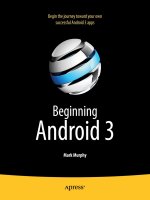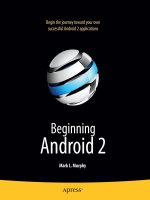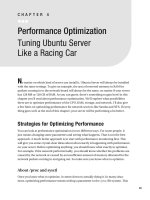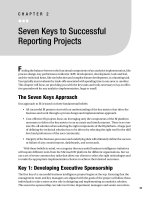apress pro android apps performance optimization (2012)
Bạn đang xem bản rút gọn của tài liệu. Xem và tải ngay bản đầy đủ của tài liệu tại đây (2.63 MB, 278 trang )
i
Pro Android Apps
Performance
Optimization
■ ■ ■
Hervé Guihot
Pro Android Apps Performance Optimization
Copyright © 2012 by Hervé Guihot
All rights reserved. No part of this work may be reproduced or transmitted in any form or by any
means, electronic or mechanical, including photocopying, recording, or by any information
storage or retrieval system, without the prior written permission of the copyright owner and the
publisher.
ISBN-13 (pbk): 978-1-4302-3999-4
ISBN-13 (electronic): 978-1-4302-4000-6
Trademarked names, logos, and images may appear in this book. Rather than use a trademark
symbol with every occurrence of a trademarked name, logo, or image we use the names, logos,
and images only in an editorial fashion and to the benefit of the trademark owner, with no
intention of infringement of the trademark.
The images of the Android Robot (01 / Android Robot) are reproduced from work created and
shared by Google and used according to terms described in the Creative Commons 3.0
Attribution License. Android and all Android and Google-based marks are trademarks or
registered trademarks of Google, Inc., in the U.S. and other countries. Apress Media, L.L.C. is not
affiliated with Google, Inc., and this book was written without endorsement from Google, Inc.
The use in this publication of trade names, trademarks, service marks, and similar terms, even if
they are not identified as such, is not to be taken as an expression of opinion as to whether or not
they are subject to proprietary rights.
President and Publisher: Paul Manning
Lead Editor: James Markham
Technical Reviewer: Charles Cruz, Shane Kirk, Eric Neff
Editorial Board: Steve Anglin, Mark Beckner, Ewan Buckingham, Gary Cornell, Morgan Ertel,
Jonathan Gennick, Jonathan Hassell, Robert Hutchinson, Michelle Lowman,
James Markham, Matthew Moodie, Jeff Olson, Jeffrey Pepper, Douglas Pundick,
Ben Renow-Clarke, Dominic Shakeshaft, Gwenan Spearing, Matt Wade, Tom Welsh
Coordinating Editor: Corbin Collins
Copy Editor: Jill Steinberg
Compositor: MacPS, LLC
Indexer: SPi Global
Artist: SPi Global
Cover Designer: Anna Ishchenko
Distributed to the book trade worldwide by Springer Science+Business Media, LLC., 233 Spring
Street, 6th Floor, New York, NY 10013. Phone 1-800-SPRINGER, fax (201) 348-4505, e-mail
, or visit www.springeronline.com.
For information on translations, please e-mail , or visit www.apress.com.
Apress and friends of ED books may be purchased in bulk for academic, corporate, or
promotional use. eBook versions and licenses are also available for most titles. For more
information, reference our Special Bulk Sales–eBook Licensing web page at
www.apress.com/bulk-sales.
The information in this book is distributed on an “as is” basis, without warranty. Although every
precaution has been taken in the preparation of this work, neither the author(s) nor Apress shall
have any liability to any person or entity with respect to any loss or damage caused or alleged to
be caused directly or indirectly by the information contained in this work.
Any source code or other supplementary materials referenced by the author in this text is
available to readers at www.apress.com. For detailed information about how to locate your book’s
source code, go to
iii
Contents at a Glance
Contents iv
About the Author viii
About the Technical Reviewers ix
Acknowledgments x
Introduction xi
■
Chapter 1: Optimizing Java Code 1
■
Chapter 2: Getting Started With the NDK 33
■
Chapter 3: Advanced NDK 73
■
Chapter 4: Using Memory Efficiently 109
■
Chapter 5: Multithreading and Synchronization 133
■
Chapter 6: Benchmarking And Profiling 163
■
Chapter 7: Maximizing Battery Life 177
■
Chapter 8: Graphics 207
■
Chapter 9: RenderScript 231
Index 265
iv
Contents
Contents at a Glance iii
About the Author viii
About the Technical Reviewers ix
Acknowledgments x
Introduction xi
■
Chapter 1: Optimizing Java Code 1
How Android Executes Your Code 2
Optimizing Fibonacci 4
From Recursive To Iterative 5
BigInteger 6
Caching Results 11
android.util.LruCache<K, V> 12
API Levels 13
Fragmentation 16
Data Structures 17
Responsiveness 20
Lazy initializations 22
StrictMode 23
SQLite 25
SQLite Statements 25
Transactions 28
Queries 30
Summary 31
■
Chapter 2: Getting Started With the NDK 33
What Is In the NDK? 34
Mixing Java and C/C++ Code 37
Declaring the Native Method 37
Implementing the JNI Glue Layer 38
Creating the Makefiles 40
Implementing the Native Function 41
Compiling the Native Library 43
Loading the Native Library 43
■ CONTENTS
v
Application.mk 44
Optimizing For (Almost) All Devices 46
Supporting All Devices 47
Android.mk 50
Performance Improvements With C/C++ 53
More About JNI 57
Native Activity 62
Building the Missing Library 64
Alternative 70
Summary 71
■
Chapter 3: Advanced NDK 73
Assembly 73
Greatest Common Divisor 74
Color Conversion 79
Parallel Computation of Average 82
ARM Instructions 87
ARM NEON 96
CPU Features 97
C Extensions 98
Built-in Functions 99
Vector Instructions 99
Tips 103
Inlining Functions 104
Unrolling Loops 104
Preloading Memory 105
LDM/STM Instead Of LDR/STD 106
Summary 107
■
Chapter 4: Using Memory Efficiently 109
A Word On Memory 109
Data Types 111
Comparing Values 113
Other Algorithms 115
Sorting Arrays 116
Defining Your Own Classes 117
Accessing Memory 118
The Cache’s Line Size 119
Laying Out Your Data 120
Garbage Collection 125
Memory Leaks 125
References 127
APIs 131
Low Memory 131
Summary 132
■
Chapter 5: Multithreading and Synchronization 133
Threads 134
AsyncTask 137
Handlers and Loopers 140
■ CONTENTS
vi
Handlers 140
Loopers 142
Data Types 143
Synchronized, Volatile, Memory Model 143
Concurrency 147
Multicore 148
Modifying Algorithm For Multicore 149
Using Concurrent Cache 152
Activity Lifecycle 154
Passing Information 156
Remembering State 158
Summary 161
■
Chapter 6: Benchmarking And Profiling 163
Measuring Time 163
System.nanoTime() 164
Debug.threadCpuTimeNanos() 165
Tracing 167
Debug.startMethodTracing() 167
Using the Traceview Tool 168
Traceview in DDMS 170
Native Tracing 172
Logging 174
Summary 176
■
Chapter 7: Maximizing Battery Life 177
Batteries 177
Measuring Battery Usage 180
Disabling Broadcast Receivers 183
Disabling and Enabling the Broadcast Receiver 186
Networking 187
Background Data 188
Data Transfer 189
Location 191
Unregistering a Listener 193
Frequency of Updates 193
Multiple Providers 194
Filtering Providers 196
Last Known Location 198
Sensors 199
Graphics 200
Alarms 201
Scheduling Alarms 203
WakeLocks 204
Preventing Issues 205
Summary 206
■
Chapter 8: Graphics 207
Optimizing Layouts 207
RelativeLayout 209
■ CONTENTS
vii
Merging Layouts 213
Reusing Layouts 214
View Stubs 215
Layout Tools 217
Hierarchy Viewer 218
layoutopt 218
OpenGL ES 218
Extensions 219
Texture Compression 221
Mipmaps 226
Multiple APKs 228
Shaders 228
Scene Complexity 229
Culling 229
Render Mode 229
Power Consumption 229
Summary 230
■
Chapter 9: RenderScript 231
Overview 231
Hello World 233
Hello Rendering 236
Creating a Rendering Script 237
Creating a RenderScriptGL Context 238
Extending RSSurfaceView 239
Setting the Content View 239
Adding Variables to Script 240
HelloCompute 243
Allocations 244
rsForEach 245
Performance 248
Native RenderScript APIs 249
rs_types.rsh 250
rs_core.rsh 253
rs_cl.rsh 255
rs_math.rsh 259
rs_graphics.rsh 260
rs_time.rsh 261
rs_atomic.rsh 262
RenderScript vs. NDK 263
Summary 263
Index 265
viii
About the Author
Hervé Guihot started learning about computers more than 20 years ago with
an Amstrad CPC464. Although the CPC464 is most likely the reason why he still
appreciates green-screened devices (ask him about his phone), Hervé started
working with Android as it became a popular platform for application
development. It was also was the only platform that combined two of his main
passions: software and pastries. After many years working in the world of
interactive and digital television, he is focused on bringing Android to more
devices to encourage more developers to leverage the power of Android and
more people to have access to the technology. Hervé is currently a software
engineering manager in MediaTek (www.mediatek.com), a leading fabless
semiconductor company for wireless communications and digital multimedia solutions. He
holds an engineering degree from the Institut de Formation Supérieure en Informatique et
Télécommunication in Rennes, Brittany, and you can sometimes find him waiting in line for an
éclair on 18th and Guerrero.
ix
About the Technical Reviewers
Charles Cruz is a mobile application developer for the Android, iOS, and
Windows Phone platforms. He graduated from Stanford University with B.S.
and M.S. degrees in Engineering. He lives in Southern California and, when
not doing technical things, plays lead guitar in an original metal band
(www.taintedsociety.com) and a classic rock tribute band. Charles can be
reached at and @CodingNPicking on
Twitter.
Shane Kirk earned his B.S. in Computer Science from the University of
Kentucky in 2000. He’s currently a software engineer for DeLorme, a mapping
and GPS technology company based in Yarmouth, Maine, where he spends his
days writing C++ and Java code for mobile and desktop applications. When
Shane isn’t coding, you’ll usually find him making lots of noise with his guitar
or lost in the pages of a good book.
Eric Neff is an experienced technical architect with more than 14 years of
overall experience in as a technical architect and senior software developer. He
is an expert in full life-cycle application development, middle-ware, and n-tier
application development, with specific expertise in Microsoft .NET application
development. He specializes in object-oriented analysis and design in systems
development with a focus on the scheduling of service personal or
manufactured items and was instrumental in the design and implementation
of data relation schemas for the lexicography industry. Eric was recently
promoted to Director of Mobile Innovations at Kiefer Consulting, Inc, putting
into practice several years of hobbyist development in the mobile space on
iPhone, Android, and Windows Mobile. Eric is active in the local development community
through his participation in the Sacramento Google Technology Group and as a board member of
the Sacramento Dot Net User Group. He has given presentations on mobile web technologies,
mobile development, and ASP.NET techniques.
x
Acknowledgments
I thank the team at Apress who made this book possible: Steve Anglin, Corbin Collins, Jim
Markham, and Jill Steinberg. Working with all of them was a real pleasure and I can with
confidence recommend them to any author.
I also want to thank the tech reviewers: Charles Cruz, Shane Kirk, and Eric Neff. They
provided invaluable feedback, often catching mistakes I would not have seen even after dozens of
readings.
To all my friends whom I did not get to see as often as I would have liked while I was working
on this book, I give my thanks too: Marcely, Mathieu, Marilen, Maurice, Katie, Maggie, Jean-René,
Ruby, Greg, Aline, Amy, and Gilles, I promise I will make up for the lost time. Last but not least, I
owe a lot to three people: Eddy Derick, Fabrice Bernard, and Jean-Louis Gassée. Sometimes all it
takes is an injured toe and a broken suitcase.
xi
Introduction
Android quickly became almost ubiquitous. With the world transitioning from feature phones to
smartphones, and then discovering that tablets are, after all, devices we can hardly live without,
application developers today have a choice between mostly two platforms: Android and iOS.
Android lowered, some may even say broke, the barrier of entry for application developers,
because all you need to write Android applications is a computer (and of course some
programming knowledge). Tools are free, and almost anyone can now write applications
reaching millions of customers. With Android now spreading to a variety of devices, from tablets
to televisions, it is important to make sure your applications can not only run well on all these
devices but also run better than competing applications. After all, the barrier of entry was lowered
for all application developers and you will in many cases find yourself competing for a slice of the
ever-growing Android applications market. Whether you write applications to make a living,
achieve stardom, or simply make the world a better place, performance will be one of the their
key elements.
This book assumes you already have some familiarity with Android application development
but want to go one step further and explore what can make your applications run faster. Although
the Android tools and online documentation make it easy to create applications, performance
optimization is sometimes more of an art than a science and is not documented as thoroughly. I
wrote Pro Android Apps Performance Optimization to help you find easy ways to achieve good
performance on virtually all Android devices, whether you are trying to optimize an existing
application or are writing an application from scratch. Android allows developers to use Java,
C/C++, and even assembly languages, and you can implement performance optimizations in
many different ways, from taking advantage of the CPU features to simply using a different
language more tailored to a specific problem.
Chapter 1 focuses on optimizing your Java code. Your first applications will most likely
exclusively use the Java language, and we will see that algorithms themselves are more important
than their implementation. You will also learn how to take advantage of simple techniques such
as caching and minimizing memory allocations to greatly optimize your applications. In
addition, you will learn how to keep your applications responsive, a very important performance
indicator, and how to use databases efficiently.
Chapter 2 takes you one step further (or lower, depending on who you talk to) and introduces
the Android NDK. Even though the Java code can be compiled to native code since Android 2.2,
using C code to implement certain routines can yield better results. The NDK can also allow you
to easily port existing code to Android without having to rewrite everything in Java.
Chapter 3 takes you to the abyss of assembly language. Albeit rarely used by most application
developers, assembly language allows you to take advantage of every platform's specific
instruction set and can be a great way to optimize your applications, though at the cost of
increased complexity and maintenance. Though assembly code is typically limited to certain
parts of an application, its benefits should not be ignored as tremendous results can be achieved
thanks to carefully targeted optimizations.
Chapter 4 shows you how using less memory can improve performance. In addition to
learning simple ways to use less memory in your code, you will learn how memory allocations
and memory accesses have a direct impact on performance because of how CPUs are designed.
■ INTRODUCTION
xii
Chapter 5 teaches you how to use multi-threading in your Android applications in order to
keep applications responsive and improve performance as more and more Android devices can
run multiple threads simultaneously.
Chapter 6 shows you the basics of measuring your applications' performance. In addition to
learning how to use the APIs to measure time, you will also learn how to use some of the Android
tools to have a better view of where time is spent in your applications.
Chapter 7 teaches you how to make sure your applications use power rationally. As many
Android devices are battery-powered, conserving energy is extremely important because an
application that empties the battery quickly will be uninstalled quickly. This chapter shows you
how to minimize power consumption without sacrificing the very things that make Android
applications special.
Chapter 8 introduces some basic techniques to optimize your applications' layouts and
optimize OpenGL rendering.
Chapter 9 is about RenderScript, a relatively new Android component introduced in
Honeycomb. RenderScript is all about performance and has already evolved quite a bit since its
first release. In this chapter you learn how to use RenderScript in your applications and also learn
about the many APIs RenderScript defines.
I hope you enjoy this book and find many helpful tips in it. As you will find out, many
techniques are not Android specific, and you will be able to re-use a lot of them on other
platforms, for example iOS. Personally, I have a sweet tooth for assembly language and I hope the
proliferation of the Android platform and support for assembly language in the Android NDK will
entice many developers, if only to learn a new skill. However, I do want to emphasize that good
design and good algorithms will often already take care of all performance optimizations you
need. Good luck, and I am looking forward to your Android applications!









